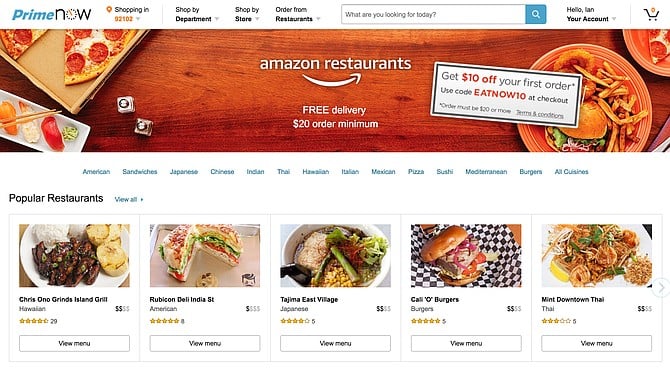 Facebook
Facebook
 X
X
 Instagram
Instagram
 TikTok
TikTok
 Youtube
Youtube

A sure sign a new market has become saturated is when the big, established companies come along and want a piece. That’s the case with web-based restaurant delivery services these days. Once the domain of a couple of plucky tech startups, the latest business to invest in the concept is the granddaddy of online shopping itself, Amazon.
A sub-brand of its Prime Now concept, Amazon Restaurants caught my attention with a $20 first-timer credit. Truth is, most of the sites and apps currently bringing dinner to your house offer similar first-time customer deals. At this point, if you’re smart about it you could probably try them all one after another and get free delivered meals for a week. Except I couldn’t get Amazon Restaurants to bring dinner to my house.
The site works fine, of course, and while it doesn’t yet have a huge list of restaurants serving my area, a lot of my favorite budget options were there. I never thought I would be able to get delivery from a nearby taco shop, for example, or from Mama’s Bakery in University Heights.
The problem, according to the site, was that when I tried to order dinner, service was “unavailable because of high order volume.” This happened on both a Saturday and Sunday night. I suppose it’s good news for Amazon that it has enough orders on deck to send customers away, but being unreliable during the dinner hour is a distinct flaw in the delivery-business model.
I settled for a rare lunchtime delivery during the week, ordering 20 dollars of sandwiches from Rubicon Deli in Mission Hills. On a Wednesday afternoon, the Amazon ordering system worked and within half an hour a couple of Rubicon’s very bready subs arrived without hassle.
I thought maybe one of Amazon’s Prime Now vans would bring the meal. I see them cruising around town, after all. But like most of the delivery and ride-sharing services about these days, the service seems to be hiring from what now must be a massive portion of our work force — contract employees competing to make money driving their cars around.
On the plus side, while Amazon requires a 20 dollar minimum order, delivery is free. And the ordering system defaults to add a 5 dollar tip to the driver. You can edit this, of course, but seeing as UberEATS encourages no tip, I’m glad to see Amazon has its drivers covered.


A sure sign a new market has become saturated is when the big, established companies come along and want a piece. That’s the case with web-based restaurant delivery services these days. Once the domain of a couple of plucky tech startups, the latest business to invest in the concept is the granddaddy of online shopping itself, Amazon.
A sub-brand of its Prime Now concept, Amazon Restaurants caught my attention with a $20 first-timer credit. Truth is, most of the sites and apps currently bringing dinner to your house offer similar first-time customer deals. At this point, if you’re smart about it you could probably try them all one after another and get free delivered meals for a week. Except I couldn’t get Amazon Restaurants to bring dinner to my house.
The site works fine, of course, and while it doesn’t yet have a huge list of restaurants serving my area, a lot of my favorite budget options were there. I never thought I would be able to get delivery from a nearby taco shop, for example, or from Mama’s Bakery in University Heights.
The problem, according to the site, was that when I tried to order dinner, service was “unavailable because of high order volume.” This happened on both a Saturday and Sunday night. I suppose it’s good news for Amazon that it has enough orders on deck to send customers away, but being unreliable during the dinner hour is a distinct flaw in the delivery-business model.
I settled for a rare lunchtime delivery during the week, ordering 20 dollars of sandwiches from Rubicon Deli in Mission Hills. On a Wednesday afternoon, the Amazon ordering system worked and within half an hour a couple of Rubicon’s very bready subs arrived without hassle.
I thought maybe one of Amazon’s Prime Now vans would bring the meal. I see them cruising around town, after all. But like most of the delivery and ride-sharing services about these days, the service seems to be hiring from what now must be a massive portion of our work force — contract employees competing to make money driving their cars around.
On the plus side, while Amazon requires a 20 dollar minimum order, delivery is free. And the ordering system defaults to add a 5 dollar tip to the driver. You can edit this, of course, but seeing as UberEATS encourages no tip, I’m glad to see Amazon has its drivers covered.
Comments